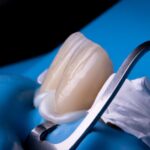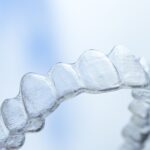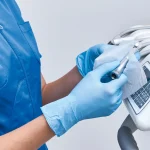
In the field of dentistry infectious agents can be transmitted by inhalation, injection, ingestion, and contact with the mucous membranes, with the conjunctiva or with the skin. [1].
In a dental practice, one of the main routes of transmission is direct exposure to blood or body fluids. Gingival bleeding mixes with saliva, which must therefore be treated and considered as potentially infected material [2].
Infection prevention and control measures are aimed at preventing or minimising the transmission of pathogens between patients and between patients and dental professionals and vice versa.
Infection control also limits the spread of infections outside the dental practice. [1].
The precautions to be adopted
We will now focus on the precautions to be adopted in order to control the spread of infection in dental practices:
Frequent hand washing
The most common route of pathogen transmission are hands.
Hand hygiene can be practised by:
- routine washing (water and soap are used for normal cleansing);
- antiseptic washing (consisting in washing hands using a soap containing antiseptic);
- surgical hand antisepsis (antiseptic hand washing carried out before a procedure by surgical personnel).
Hand hygiene should be practised:
- before and after the treatment of each patient (before putting on personal protective equipment and after removing it;
- after touching with bare hand objects contaminated with body fluids (blood saliva, oral and respiratory secretions);
- before touching sterile instruments, be they bagged or unbagged;
- before putting on gloves for a surgical procedure (surgical hand antisepsis);
- during cleaning: after washing instruments, after cleaning dental devices and on completing decontamination operations;
- before leaving the dental practice.[1]
Use of personal protective equipment (PPE)
Personal protective equipment (PPE), or protective barriers, are essential components of the standard precautions, because they protect from sprays or splashes that potentially contain infectious agents.
They include: face masks, gloves, protective clothing and protective glasses.[1]
Face masks
Face masks protect the operator’s nasal and oral mucosae and skin on the face and neck from splashes, but they do not provide protection from aerosols. Face masks must fit snugly against the face in order to serve their function properly[2].
A face mask is a disposable device and its filtration capacity must be taken into consideration. As filtration efficacy starts to diminish after 20 minutes of use due to moisture, when they become moist, face masks must be changed during longer procedures.
Constant face mask use also avoids contaminating environmental surfaces with the respiratory secretions of the operator.
Gloves
Glove use does not replace hand washing, which must be carried out before putting gloves on and after removing them.
Gloves must be replaced in the case of a tear, cut or puncture. Cuts or grazes on the skin of the hands can provide a point of entry for microorganisms and must therefore be covered before using gloves [1].
Clothing and footwear
Protective clothing must be worn when the procedure involves a risk of contamination with significant body fluids or in the case of procedures that generate aerosols.
As these gowns have long sleeves that become contaminated during treatment and complicate hand hygiene, they must be changed after each patient.
Footwear must be closed in order to protect against cut wounds should an object accidentally fall. It must also be non-slip and easy to clean [2].
Glasses and face shields
Eye protection is essential during scaling procedures and when using rotating devices.
Glasses protect the eyes from penetrating injuries and from splashes and sprays of body fluids. They are also recommended for patients in order to reduce the risk of physical or chemical injuries caused by the materials used during the treatment [1].
Face shields are recommended when the procedure is expected to generate significant aerosols or splashes.
As they do not protect from airborne pathogens, glasses and face shields must always be worn with a surgical face mask.
Appropriate handling of sharps
A sharp is any object with the potential to cut, catch or cause injuries.
The most common examples of sharps are needles and scalpel blades. However, other objects, such as matrices, endodontic files and wires, can also cause percutaneous injuries and must therefore be handled properly.
Disposable sharps must be placed in a puncture-resistant container (rigid bin), located as close as possible to the area in which they are used. These containers must never be too full (no more than two thirds of their full capacity). [7]
Cleaning, disinfecting and sterilising equipment
We will now review the instrument cleaning, disinfecting and sterilisation procedures used when treating a patient.
Mechanical and manual cleaning
Before sterilisation, it is preferable to clean instruments mechanically rather than manually.
This is because mechanical cleaning is more effective and reduces the risk of percutaneous lesions or exposure to blood [8].
Mechanical cleaning can be carried out using thermal disinfectors, also known as instrument washers or ultrasonic cleaners.
Manual cleaning is therefore not recommended; however, if it is preferred, it must be carried out in a dedicated sink, used exclusively for cleaning instruments, filled with warm water and cleaner.
Hot water must not be used, as it favours the clotting of proteins, whereas cold water solidifies lipids, which makes removing the debris from instruments more complicated.
Instruments must be cleaned with a long-handled brush, holding them low and under the water in the sink.
After cleaning, they must be rinsed under warm or hot water (hot water accelerates drying) and inspected under an magnifying glass and appropriate light.
Cleaning the dental unit and radiology equipment
All the appliances that can be removed from the dental unit must be sterilised, including handpieces.
Want to find out more about disinfecting a dental unit?
Discover the suction unit cleaning protocol
Radiology equipment, lights and dental chairs must be disinfected using chemical agents [7].
In order to reduce contamination during use, digital radiography sensors must be protected with a transparent barrier, before proceeding with cleaning and thermal sterilisation, or high-level disinfection, between one patient and the next. [1]
Clinical contact surfaces must be covered with protective barriers and changed after each patient. Soaking instruments in an appropriate chemical agentcan be used, for disinfection purposes, also before sterilisation [7].
The purpose of this is to destroy all active microorganisms, including bacterial spores, from the instruments. The most common sterilisation methods used in dentistry are pressurised steam sterilisation and dry heat sterilisation [1].
Pressurised steam sterilisation (autoclaving)
Pressurised steam sterilisation (autoclaving) is the most common method used in dentistry.
It is practical and rapid, and makes it possible to assess sterilisation efficacy. Autoclave sterilisation uses high-temperatures cycle of 121 °C or 134 °C [2].
The disadvantage is that the instruments that cannot be subjected to high temperatures cannot be autoclaved.
Autoclave sterilisation tends to rust carbon steel instruments and burs, which must therefore be air-dried at the end of the cycle [1].
Dry steam sterilisation
This method uses conventional dry steam ovens, with a short cycle and high temperatures, for items that cannot be exposed to wet heat or static or forced air.
As high temperatures can damage heat-sensitive objects, longer, lower temperature cycles are used and the ovens must be calibrated.
Dry heat sterilisation does not corrode instruments and makes it possible to assess sterilisation efficacy [1].
Prevention culture
Dental practices are considered a work environment entailing a biological risk and therefore all practice personnel must be familiar with the protocols for minimising percutaneous injuries, which must be reviewed and checked regularly.
It is necessary to consider each patient a potential carrier of transmissible infectious disease, always maintaining a constant level of vigilance and adopting decontamination, disinfection and sterilisation procedures aimed at preventing or reducing the potential transmission of disease from patient to staff (dentists, dental hygienists, dental nurses and dental technicians), from staff to patient, and also from patient to patient.
Such conduct is also governed by specific legal provisions: the prevention of infectious risk is based on the systematic adoption of the measures referred to in Title X of Italian Legislative Decree 81/08 and the specific measures provided for by Italian Ministerial Decree of 28/9/90[6].
For the safety of practitioners and patients, Zhermack offers the vast range of Zeta Hygiene products, designed for specific uses against the main types of microorganism and compliant with the most recent European regulations.
References
[1] Sebastiani FR, Dym H, Kirpalani T. Infection Control in the Dental Office. Dent Clin North Am. 2017 Apr;61(2):435-457;
[2] Thomas MV, Jarboe G, Frazer RQ. Infection control in the dental office. Dent Clin North Am. 2008 Jul;52(3):609-28;
[3] Araujo MW, Andreana S. Risk and prevention of transmission of infectious diseases in dentistry. Quintessence Int. 2002 May;33(5):376-82;
[4] McCarthy GM. Risk of transmission of viruses in the dental office. J Can Dent Assoc. 2000 Nov;66(10):554-5, 557;
[5] Sebastiani FR, Dym H, Kirpalani T. Infection Control in the Dental Office. Dent Clin North Am. 2017 Apr;61(2):435-457;
[6]https://online.scuola.zanichelli.it/fondamentignatologia/files/2022/08/La_dinfezione_in_ambito_odontoiatrico.pdf
[7] Cabrera-Tasayco FDP, Rivera-Carhuavilca JM, Atoche-Socola KJ, Peña-Soto C, Arriola-Guillén LE. Biosafety Measures at the Dental Office After the Appearance of COVID-19: A Systematic Review. Disaster Med Public Health Prep. 2021 Dec;15(6):e34-e38.
[8] Miller CH, Tan CM, Beiswanger MA, Gaines DJ, Setcos JC, Palenik CJ. Cleaning dental instruments: measuring the effectiveness of an instrument washer/disinfector. Am J Dent. 2000 Feb;13(1):39-43.
Do you want more information on Zhermack Dental products and solutions?
Contact us




 Zhermack SpA has been one of the most important producers and international distributors of alginates, gypsums and silicone compounds for the dental sector for over 40 years. It has also developed solutions for the industrial and wellbeing sectors.
Zhermack SpA - Via Bovazecchino, 100 - 45021 Badia Polesine (RO), Italy.
Zhermack SpA has been one of the most important producers and international distributors of alginates, gypsums and silicone compounds for the dental sector for over 40 years. It has also developed solutions for the industrial and wellbeing sectors.
Zhermack SpA - Via Bovazecchino, 100 - 45021 Badia Polesine (RO), Italy.


